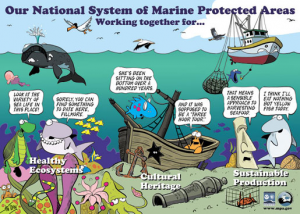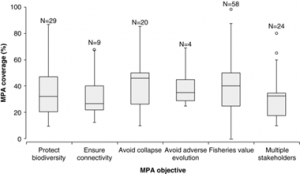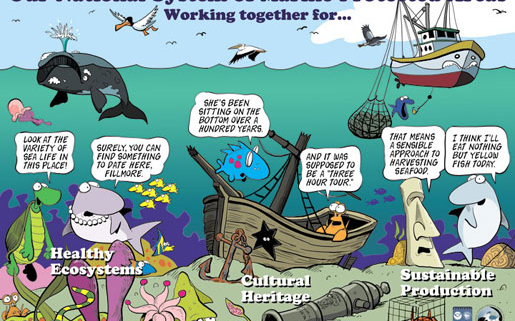Marine Protected Areas Play a Crucial Role in Conservation and Fisheries Management
By Abby Tinari, SRC Intern

A cartoon by Jim Toomey illustrating the importance of marine protected areas.
Marine protected areas (MPAs) are put in place to protect natural resources from anthropogenic impacts. They play a crucial role in biodiversity conservation and fisheries management, allowing for the protection of nurseries and breeding grounds for rare or commercially important species.
Introduction
MPAs attempt to maximize fishery yields while protecting against overfishing and fishery collapse. In turn, this aims to provide a sustainable market, as well as combat the negative evolutionary effects of fishing. MPAs have arbitrary borders; they are not permanent structures, fish can pass through the borders and therefore spillover into areas outside of the MPA, protecting fish in other areas as well. They attempt to increase connectivity between communities and biodiversity of the area and its surroundings. In their research, O’Leary et. al. found that an objective of MPAs beyond protection and conservation is to satisfy policy makers, workers, and environmentalists, who are all stakeholders in MPAs. Often in areas where MPAs are to be established, waters have been and still are a major source of income for many families. The creation of a marine protected area does not (and should not) mean the taking away of that livelihood, but rather an attempt to help it last far into the future.
The Research
The globally adopted Convention on Biological Diversity (a United Nations, UN, program) has a target to make 10% of the marine environment into a marine protected area by the year 2020 (O’Leary et al., 2016). In O’Leary’s study, his team performed a literature search to determine if this 10% goal was sufficient to protect and preserve biodiversity, ecosystems and achieve different socioeconomic priorities. If the 10% UN goal was not adequate the authors looked to see what the percentage of MPAs that needed to be protected in order to meet the most objectives. Just marine environments were studied. Studies were taken from around the world in both temperate and tropical climates.
The UN’s 10% goal, although a good start does not provide nearly enough protection to support all of MPAs objectives, just as indicated by previous reviews in 2003 and 2010 (O’Leary et al., 2016). To achieve the different sustainability objectives, 30% – 40% of area devoted to MPAs is much more likely needed. (Figure 1). The average and the median were consistently in the 30% to 40% range, indicating, if all objectives were to be met, this would be the ideal MPA percentage range. If the surrounding areas outside of the MPA, as well as inside, are managed properly the lower percentages of MPA are likely to work. The MPAs burden will be lessened with proper management and enforcement both in and outside the area. Within the literature, temperate and tropical regions were studied and those papers were compared. The authors found that no significant difference in the amount of MPA percent coverage was found in terms of their geographical region. MPAs are just as important and effective in accomplishing their objectives in South Florida as they are in the Mediterranean Sea.

Figure 1 – MPA coverage and the subsequent objectives
With greater MPA coverage worldwide, how well the areas meet the objective in the study should increase. MPAs have the ability to contribute greatly to fisheries through protected nurseries and spawning ground that lead to an increase in biomass for fishing. For an MPA to be successful, however, it must have support and input from all stakeholders, so that a compromise can be made with minimal conflict from the parties. The authors note that this finding is simply a perspective, and is in no way a recommendation on what the UN’s target should be.
References
http://oceanservice.noaa.gov/news/weeklynews/may09/mpalist.html
O’Leary, B. C., Winther-Janson, M., Bainbridge, J. M., Aitken, J., Hawkins, J. P., & Roberts, C. M. (2016). Effective Coverage Targets for Ocean Protection. Conservation Letters, n/a-n/a. doi:10.1111/conl.12247




Leave a Reply
Want to join the discussion?Feel free to contribute!